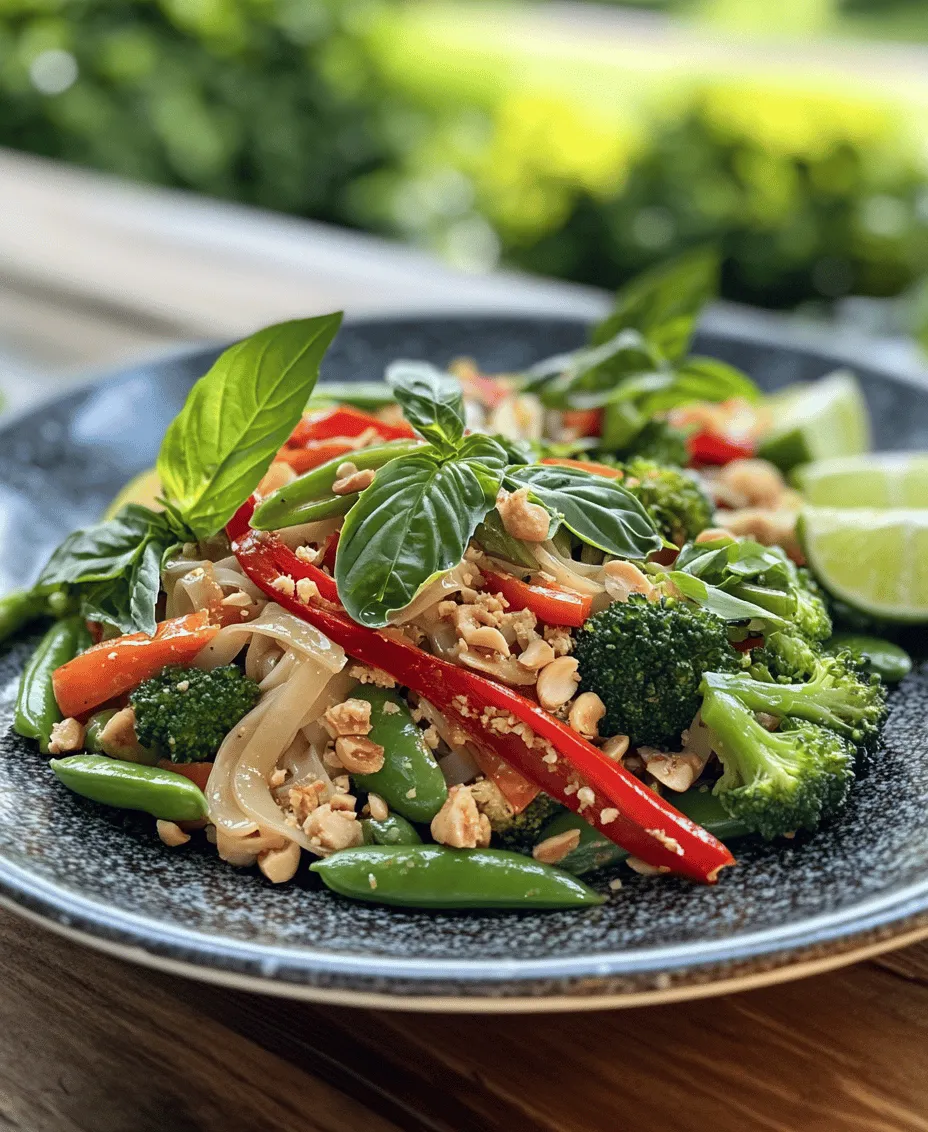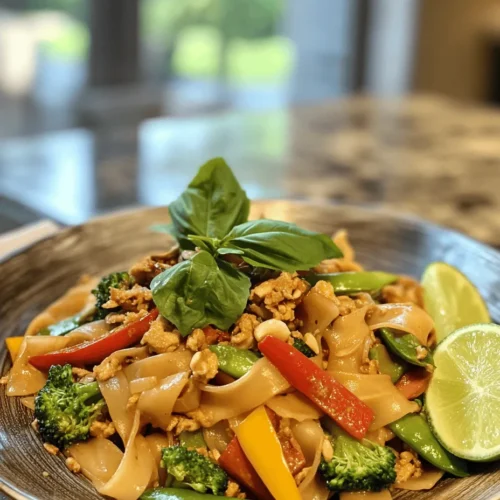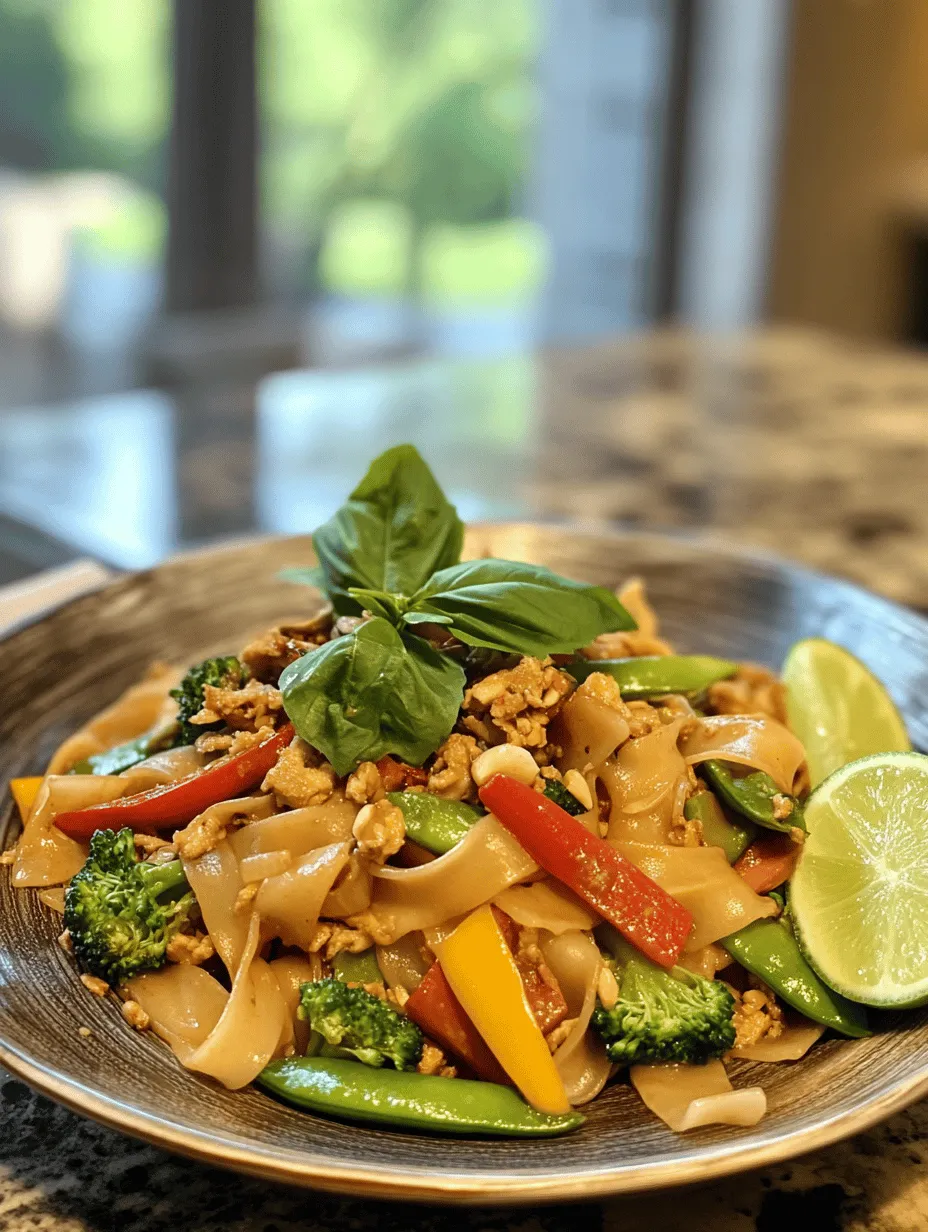Introduction to Spicy Thai Drunken Noodles
In the vibrant realm of Thai cuisine, few dishes capture the essence of bold flavors and delightful aromas as effectively as Spicy Thai Drunken Noodles. Known as “Pad Kee Mao,” this popular street food is a favorite among both locals and tourists for its spicy kick, satisfying texture, and aromatic profile. With its harmonious mix of fresh vegetables, aromatic herbs, and tender rice noodles, Spicy Thai Drunken Noodles is not just a meal; it’s an experience that transports you to the bustling streets of Thailand.
This dish is celebrated for its dynamic flavors, which can vary from sweet to spicy, making it an exciting choice for anyone looking to explore the depths of Thai cooking. In this article, we will delve into the origins, essential ingredients, and step-by-step preparation of Spicy Thai Drunken Noodles, ensuring you master this dish and impress your family and friends with your culinary skills.
The Cultural Significance of Drunken Noodles
Exploring the Origins of Pad Kee Mao
The origins of Pad Kee Mao, or Drunken Noodles, are steeped in the rich history of Thai street food culture. This dish is believed to have been created as a late-night snack for those who enjoyed a night out, hence the name “drunken.” The combination of flavors and ingredients was designed to satisfy late-night cravings, providing a robust meal that could help soak up the effects of a night of revelry. Although its exact origins are somewhat murky, it is widely accepted that Pad Kee Mao has roots in the central region of Thailand, where rice noodles are a staple food.
Understanding the Meaning Behind the Name
The name “Pad Kee Mao” translates to “drunken fried noodles,” and it reflects more than just the dish’s late-night appeal. The term “drunken” is often attributed to the dish’s intended pairing with alcoholic beverages, making it a popular choice for those winding down after a night out. However, some culinary experts also suggest that the name refers to the chaotic and haphazard way in which the dish is prepared, with its vibrant ingredients tossed together in a delightful frenzy.
The Role of Drunken Noodles in Thai Street Food Culture
Drunken Noodles hold a special place in Thai street food culture. They are commonly found in local food stalls, bustling markets, and on the menus of casual eateries throughout Thailand. The accessibility and appeal of this dish make it a staple for many, serving as a quick and satisfying meal that can be enjoyed at any time of day. As street food continues to gain popularity worldwide, Spicy Thai Drunken Noodles have emerged as a beloved dish among food enthusiasts, showcasing the unique flavors and cooking techniques that define Thai cuisine.
Ingredients Breakdown for Spicy Thai Drunken Noodles
Key Components of the Dish
To create an authentic and delicious plate of Spicy Thai Drunken Noodles, it is essential to understand the key components that contribute to its unique flavor and texture.
Overview of Rice Noodles: Types and Best Choices
The foundation of Spicy Thai Drunken Noodles is the rice noodle, which provides a chewy texture that absorbs the flavors of the accompanying ingredients. There are several types of rice noodles available, but the best choices for this dish are wide rice noodles (often labeled as “sen yai”) or medium rice noodles (often labeled as “sen mee”).
– Sen Yai (Wide Rice Noodles): These flat noodles are typically used in Pad See Ew and are perfect for capturing the sauce and flavor of Drunken Noodles.
– Sen Mee (Medium Rice Noodles): These thinner noodles work well in stir-fries and cook quickly, making them another excellent option for this dish.
Properly selecting and preparing the rice noodles is crucial, as they provide the base for all the other delicious flavors in the dish.
The Importance of Fresh Vegetables: Nutritional Benefits
Fresh vegetables are not only essential for adding color and texture to Spicy Thai Drunken Noodles, but they also contribute significant nutritional value. Common vegetables used in this dish include bell peppers, carrots, and Chinese broccoli (also known as “kai lan”).
– Bell Peppers: These flavorful vegetables add sweetness and crunch, along with a vibrant color to your dish.
– Carrots: These provide a natural sweetness and a satisfying crunch, complementing the softness of the rice noodles.
– Chinese Broccoli: This leafy green is a staple in Thai cooking, adding both nutrition and an earthy flavor.
Incorporating a variety of fresh vegetables into your noodles not only enhances the dish’s visual appeal but also boosts its nutritional profile, making it a wholesome meal option.
Herbs and Spices: Elevating Flavor with Thai Basil and Chilies
No dish would be complete without the aromatic herbs and spices that define Thai cuisine. In Spicy Thai Drunken Noodles, the star ingredient is Thai basil, which imparts a sweet and slightly peppery flavor that elevates the dish to new heights.
– Thai Basil: This herb is essential for authenticity, offering a flavor profile distinct from sweet basil. It’s often used in Thai stir-fries and curries for its aromatic qualities.
– Chilies: Fresh or dried chilies are crucial for achieving the signature heat of Drunken Noodles. Depending on your spice tolerance, you can adjust the number of chilies used to create the perfect balance of heat.
Essential Sauces That Bring It All Together
The flavor of Spicy Thai Drunken Noodles is largely dependent on the combination of sauces used in the recipe. Each sauce plays a unique role in enhancing the overall taste of the dish.
Soy Sauce: The Umami Factor
Soy sauce is a staple in many Asian cuisines and serves as the primary source of umami flavor in Spicy Thai Drunken Noodles. The salty, savory notes of soy sauce help to deepen the flavor of the dish, adding richness that complements the other ingredients.
Oyster Sauce: Adding Depth
Oyster sauce is another key ingredient that contributes to the complexity of flavors in Drunken Noodles. This thick, dark sauce is made from oyster extracts and provides a slightly sweet and savory taste that enhances the overall flavor profile of the dish.
Fish Sauce: A Signature of Thai Cooking
Fish sauce is a quintessential ingredient in Thai cooking, known for its strong, pungent flavor. A few drops of fish sauce in Spicy Thai Drunken Noodles can significantly elevate the dish, adding a depth of flavor that is characteristic of authentic Thai cuisine.
The Sweet and Sour Balance: The Role of Sugar and Lime Juice
To achieve the perfect balance of flavors in your Drunken Noodles, it’s essential to incorporate a touch of sweetness and acidity. Sugar (often palm sugar) is commonly used to counterbalance the saltiness of the sauces, while a squeeze of lime juice adds a refreshing acidity that brightens the dish. The combination of these elements creates a harmonious flavor profile that is both satisfying and exciting to the palate.
Preparation Steps for Spicy Thai Drunken Noodles
How to Perfectly Soak and Prepare Rice Noodles
The first step in making Spicy Thai Drunken Noodles is properly preparing the rice noodles. The right preparation is crucial for achieving the ideal texture and ensuring that your noodles do not become mushy.
The Importance of Proper Noodle Preparation
Begin by soaking the rice noodles in warm water for about 30 minutes, or until they are just pliable. This soaking process softens the noodles and allows them to absorb water without cooking them fully. After soaking, drain the noodles and rinse them under cold water to stop the cooking process. This will help maintain their firmness when stir-frying later on.
Tips for Achieving the Right Texture
To achieve the perfect texture in your rice noodles, it’s essential to avoid over-soaking. If the noodles are too soft before cooking, they can easily break apart during the stir-fry process. When you’re ready to cook, it’s best to have all your ingredients prepped and ready to go, as stir-frying is a quick process.
Crafting the Flavorful Sauce
Once your noodles are prepared, it’s time to create the flavorful sauce that will bring your Spicy Thai Drunken Noodles to life.
Combining Sauces for a Balanced Profile
In a small bowl, combine soy sauce, oyster sauce, fish sauce, and sugar. Stir until the sugar is dissolved and the ingredients are well blended. Adjust the proportions to suit your taste preference, ensuring that the flavors are balanced between salty, sweet, and umami.
Tips for Adjusting Spice Levels
If you prefer a spicier version of Drunken Noodles, consider adding extra chopped chilies or a dash of chili paste to the sauce mixture. Taste the sauce before adding it to the stir-fry, and make adjustments as necessary to achieve your desired heat level.
Sautéing Aromatics and Vegetables
With your noodles soaked and your sauce prepared, it’s time to bring everything together by sautéing the aromatics and vegetables.
Start by heating a wok or large skillet over medium-high heat and adding a splash of oil. Once the oil is hot, add minced garlic and sliced chilies, stirring quickly to infuse the oil with their flavors.
Next, add your prepped vegetables to the wok and stir-fry for just a couple of minutes until they begin to soften but still retain a bit of crunch. This quick cooking method helps to preserve the vibrant colors and nutritional value of the vegetables, ensuring a delicious and visually appealing dish.
As you sauté the vegetables, keep an eye on the heat level to avoid burning the garlic and chilies, which can impart a bitter flavor. Once the vegetables are cooked to your liking, you can proceed to add the soaked rice noodles and the prepared sauce, continuing to stir-fry until everything is well combined and heated through.
By following these detailed preparation steps, you’ll be well on your way to mastering the art of Spicy Thai Drunken Noodles. This dish not only embodies the vibrant flavors of Thailand but also offers a fun and interactive cooking experience that you can enjoy with family and friends.

The Best Techniques for Stir-Frying: High Heat and Quick Cooking
When it comes to preparing Spicy Thai Drunken Noodles, mastering the art of stir-frying is crucial. The key is to use high heat and cook quickly, allowing the ingredients to retain their texture and flavor. Start by heating your wok or large frying pan until it’s smoking hot. This high temperature is essential for achieving that characteristic smoky flavor that is synonymous with Thai cuisine.
Once the pan is hot, add a small amount of oil—preferably a high smoke point oil like vegetable or peanut oil. Immediately follow with your protein and vegetables to sear them, ensuring they cook evenly and quickly. The rapid cooking helps to lock in moisture and keeps the vegetables crisp, providing the perfect contrast to the soft noodles.
Choosing the Right Vegetables for Crispness
When selecting vegetables for your Spicy Thai Drunken Noodles, it’s important to choose those that will maintain their crunch during cooking. Vegetables such as bell peppers, snap peas, broccoli, and carrots work beautifully. Not only do they add vibrant colors to your dish, but their textures also complement the soft noodles.
For the best results, cut your vegetables into uniform pieces. This ensures even cooking, so some pieces do not turn mushy while others remain raw. Incorporating a variety of colors not only enhances the visual appeal of your dish but also maximizes the nutritional value.
Combining Ingredients for Maximum Flavor
As you prepare your stir-fry, timing is everything. Begin by adding your protein (tofu, chicken, shrimp, or beef) to the pan first. Allow it to sear for a couple of minutes before adding your vegetables. Once the protein and veggies are sizzling, it’s time to introduce your sauce, typically made from soy sauce, oyster sauce, and a hint of sugar.
To ensure that every noodle is coated with flavor, pour the sauce in a well around the noodles rather than directly on top. This technique allows the heat to help the sauce infuse into the ingredients, creating a harmonious blend of flavors.
Techniques for Tossing Noodles Without Clumping
One of the common challenges when making stir-fried noodles is preventing them from clumping together. To avoid this, make sure your noodles are cooked al dente and rinsed under cold water before adding them to the pan. This stops the cooking process and removes excess starch, which can cause sticking.
When it’s time to toss the noodles, use a combination of a spatula and your wrist. Lift the noodles gently while turning the pan to incorporate them with the other ingredients. This technique helps maintain the integrity of the noodles and ensures an even distribution of flavors throughout the dish.
The Role of Timing in Adding Ingredients
Timing is critical in stir-frying to maintain the flavors and textures of your ingredients. After you’ve added your vegetables and protein, monitor their cooking times closely. Start with the ingredients that take longer to cook, like carrots and broccoli, followed by quicker-cooking items like bell peppers and snap peas.
Finally, add the cooked noodles in the last minute of cooking. This allows the noodles to soak up the flavors of the sauce and ensures they are heated through without becoming overcooked.
Incorporating Optional Ingredients
While the classic Spicy Thai Drunken Noodles recipe is delicious on its own, feel free to personalize it by adding optional ingredients. For example, you might consider adding fried eggs for a protein boost. Eggs can be scrambled separately and then added to the noodles at the end, or you can cook them directly in the pan before adding the other ingredients.
The Use of Eggs: Enhancing Protein Content
Incorporating eggs into your Spicy Thai Drunken Noodles not only enhances the protein content but also contributes a creamy texture. If you prefer a richer dish, scramble one or two eggs in the pan before adding the other ingredients. The eggs will coat the noodles, adding depth to the flavors and making the dish more filling.
Adjusting Texture and Flavor with Eggs
To achieve the perfect balance, consider how the eggs will impact the overall flavor profile. Adjust the seasoning of your sauce if you find that the scrambled eggs dominate the dish. A bit of extra soy sauce or a hint of fish sauce can help bring back the robust flavors associated with traditional Thai cooking.
Finishing Touches: Adding Thai Basil and Chilies
No Spicy Thai Drunken Noodles would be complete without the aromatic addition of fresh Thai basil. This herb not only adds a burst of flavor but also enhances the dish’s aromatic quality. Add the basil towards the end of cooking to preserve its freshness and vibrant taste.
For those who enjoy a bit more heat, consider adding sliced Thai bird chilies. These tiny peppers pack a punch, so adjust the quantity based on your spice tolerance. Remember, you can always add more heat, but you can’t take it away once it’s in!
The Importance of Fresh Herbs in Thai Cuisine
Fresh herbs are a cornerstone of Thai cooking, elevating the dish and adding complexity. Besides Thai basil, consider incorporating cilantro or mint for additional flavor layers. These herbs can be sprinkled on top just before serving, brightening the dish and enhancing its visual appeal.
Balancing Heat: How to Control Spice Levels
When cooking Spicy Thai Drunken Noodles, controlling the spice level is essential, especially if you’re catering to varied taste preferences. The primary source of heat comes from the chilies, but you can also adjust the amount of chili sauce or paste used in the dish.
If you find your dish is too spicy, balance it with a bit of sugar or a splash of coconut milk, which can help mellow out the heat without compromising the overall flavor.
Serving Suggestions for Spicy Thai Drunken Noodles
Once your Spicy Thai Drunken Noodles are ready, it’s time to serve! Presentation can elevate the dining experience, so consider the following suggestions.
Plating the Dish for Visual Appeal
Use a large, shallow bowl or plate to showcase the noodles. Twirl the noodles into a nest-like structure in the center, and arrange your vibrant vegetables and protein around it. This not only looks great but also makes it easy for diners to serve themselves.
Garnishing with Fresh Lime Wedges
A squeeze of fresh lime just before eating adds brightness and acidity, enhancing the flavors of your dish. Place a couple of lime wedges on the side for guests to use as they please. The zesty lime complements the spicy noodles beautifully.
Pairing with Other Thai Dishes
Spicy Thai Drunken Noodles can be complemented by other traditional Thai dishes. Consider serving alongside a fresh papaya salad for a perfect balance of flavors and textures. Alternatively, a light Thai soup can serve as a delightful starter.
Exploring Beverage Pairings
To further enhance your dining experience, consider what beverages pair well with your Spicy Thai Drunken Noodles.
Suggested Drinks to Complement the Spicy Profile
A crisp, cold beer such as a lager or pilsner works wonderfully to cut through the spiciness of the noodles. If you prefer non-alcoholic options, a sweet iced tea or coconut water can be refreshing choices that balance the heat.
Nutritional Information of Spicy Thai Drunken Noodles
When preparing Spicy Thai Drunken Noodles, it’s helpful to understand the nutritional information, particularly if you’re mindful of dietary needs.
Caloric Breakdown and Health Benefits
This dish offers a well-rounded meal, providing carbohydrates from the noodles, protein from your choice of meat or tofu, and a wealth of vitamins from the vegetables. Depending on your ingredient choices, a standard serving can range from 400 to 600 calories.
Nutritional Value of Main Ingredients
– Rice Noodles: A good source of carbohydrates, low in fat, and gluten-free.
– Vegetables: Rich in vitamins A, C, and K, as well as fiber.
– Protein (Tofu/Chicken/Shrimp): Provides essential amino acids and supports muscle health.
Understanding Portion Control
Like any dish, portion control is key to enjoying Spicy Thai Drunken Noodles as part of a balanced diet. A standard serving size is approximately one cup of noodles with an ample amount of vegetables and protein. Consider pairing with a side salad or soup to create a more filling meal without overindulging.
Conclusion: Enjoying Your Homemade Spicy Thai Drunken Noodles
Reflecting on the joy of cooking and sharing your Spicy Thai Drunken Noodles, it becomes clear that this dish is not just about satisfying hunger—it’s about bringing people together. The vibrant flavors and intoxicating aromas are sure to impress family and friends alike.
Making Spicy Thai Drunken Noodles at home allows you to explore authentic Thai flavors, customize spice levels, and enjoy a meal that resonates with the heart of Thai cuisine. So gather your ingredients, embrace the techniques, and savor the delightful experience of creating this beloved dish in your own kitchen. Whether enjoyed on a casual weeknight or at a special gathering, Spicy Thai Drunken Noodles are a celebration of flavor, culture, and community.



